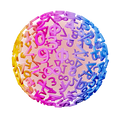What Is the Place-value System?
A number in the decimal numeral system is made up of digits, placed in different combinations. The structure of the numbers follows a system. That system is what we call the place-value system.
The place-value system is built up in such a way that each place where you can put a digit has a certain value. You can use as many places as you want to, like the thousandths place and the millionths place. Here are the different decimal places:
-
Thousandths place: Place-value
-
Hundredths place: Place-value
-
Tenths place: Place-value
-
Ones place: Place-value
-
Tens place: Place-value
-
Hundreds place: Place-value
-
Thousands place: Place-value
-
Ten thousands place: Place-value
Video Crash Courses
Want to watch animated videos and solve interactive exercises about thousandths? Click here to try Video Crash Courses!
Example 1
In the number , the is in the tens place and the is in the ones place. You can split up the number by using the values from the place-value system. That means that you have the place-value the same number of times as the digit in the place. It becomes like this:
Meaning that you have
Example 2
In the number , is in the hundreds place, in the tens place and in the ones place. You can split up the number by using the values from the place-value system. That means you have the place-value the same amount of times as the digit in the place. It becomes like this:
Example 3
In the number , is in the ones place, is in the tenths place and in the hundredths place. You can split up the number by using the values from the place-value system. That means you have the place-value the same amount of times as the digit in the place. It becomes like this:
The Structure of the Place-value System
All digits to the left of the ones place are multiplied by one or more times.
All digits to the right of the point are divided by one or more times.
A number moves to the next place in the place-value system when it’s multiplied by The names of the places in each direction continue like this infinitely.
It’s very useful to understand how the place-value system is structured. As you grow older, you’ll come across extremely large and small numbers that go way past what you saw above.
Example 4
This number has no decimal point:
But, there’s an invisible point behind the last digit. When you don’t have any decimals, you don’t have to write the point. The last digit in the number is in the ones place.
Example 5
Look at the number
Here the is in the tens place, is in the ones place and is in the tenths place. You can write the number as a sum to show the reasoning:
Example 6
Look at the number
Here is in the thousands place, is in the hundreds place, is in the tens place, is in the ones place, is in the tenths place. is in the hundredths place and is in the thousandths place. You can write the number as a sum to show the reasoning:
Math Vault
Want to solve exercises about the place-value system? Try Math Vault!





















